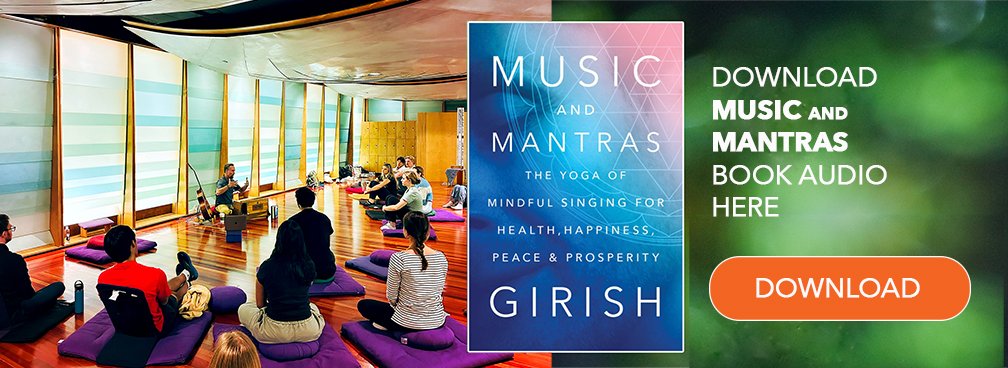KIRTAN EVOLUTION 104
Online Kirtan Training
April 7 - 28
Join us for a life changing, online interactive month-long journey into Music and Mantra bliss with GIRISH and special guest, WAH, beginning April 7!
The experience of sharing in the joy of playing harmonium, guitar, voice, or any other musical instrument you choose, learning your favorite chants and songs, and finding completely new levels of freedom and power in your singing voice - even daring to share your own Kirtan practice with our safe, loving sangha - in a month-long series of live, interactive sessions with an amazing global community is the hallmark of the KIRTAN EVOLUTION series.
This series is open to one and all, whether you’re just getting started with Kirtan practice or you’ve been playing for years. You’ll be supported and inspired whatever your playing experience is! All are welcome!!
We’ll meet on four consecutive Mondays at 4 PST / 7 EST for 90 minutes each, from April 7 - 28. Each live, interactive session is recorded and is yours to enjoy on-demand anytime. An abundance of music resources, song charts, and video tutorials are also yours to accompany you on your journey through this course!
The cost for the month-long immersion is $108, which can be paid through the link below. And... we never want finances to be an obstacle to receiving any of our Prana Rising offerings. Those needing a scholarship to attend this immersion can simply email GIRISH@GIRISHMUSIC.ORG to arrange it.
YOGA REACHES OUT
May 4, 8 am - 2 pm
Yoga Reaches Out harnesses the power of the yoga community to give lifesaving answers to patients at Boston Children's Hospital and around the world. Join us for an inspiring day filled with yoga, friends, and fundraising that benefits kids. Girish and his amazing band will be there to fuel our yoga flow during this soulful Sunday event! See you there!
KIRTAN EVOLUTION BAHAMAS RETREAT
November 14 - 19, 2025
There’s a song that’s yearning to sing through all of us...
Join us as we find our soul’s Voice together in one of the most pristinely beautiful and sacred places in the world. We’ll share 6 blissful, life-changing days together on Paradise Island, Bahamas, as we learn some of the most deeply healing mantra music on the planet! For this year’s retreat you’re invited to explore and learn on Harmonium, Guitar, Drums, Keyboard, or just the sound of your own beautiful Voice! Learn more and register through through the link below.
LAKSHMI LOTUS
ESSENTIAL OIL BLEND
An intoxicatingly beautiful blend that opens the lotus of the heart to the abundant grace
flowing in each and every moment.
This blend was envisioned and hand blended by Girish, using the finest organic essential oils. lakshmi lotus features an exquisite Pink Lotus and Morrocan Rose in a base of the finest sandalwood, blended with Amber Essence and Vanilla to create a sensually sacred aromatic experience.
Available in a 5 ml bamboo roller or dropper bottle.
GREEN TARA
ESSENTIAL OIL BLEND
An aromatic invocation of the healing energies of Tara, the mother of the buddhas and the embodiment of compassion and wisdom.
This heavenly, expansive blend features two of the world’s finest sandalwood oils, along with the green, cooling fragrance of Wild Indian Khus and the sparkling citrus scent of Japanese Yuzu.
Available in 5 ml glass droppers or bamboo rollers.
PRANA RISING
ESSENTIAL OIL BLEND
A very special, handmade blend of essential oils to inspire profound grounding and emotional balance, while expanding the heart and mind to create an aromatic sacred space.
This blend was envisioned by master aromatherapist Allison Stillman, and hand blended by Girish with the following organic essential oils:
CEDARWOOD FRANKINCENSE PERU BALSAM YLANG YLANG
Available in a 5 ml bamboo roller or dropper bottle.
Pure Frankincense Oil
The world’s finest Frankincense oil, Boswellia Sacra, imported in Oman by Enfleurage. Transform your home into a sacred space by diffusing this incredibly healing and uplifting fragrance, or add a drop or two to your favorite skin care products to experience the legendary benefits of frankincense on your body’s biggest organ. Comes in a 5 ml dropper bottle.
HARMONIUM IMMERSION PREVIOUS ROUNDS
ON-DEMAND
PURCHASE PREVIOUS ROUNDS OF THE HARMONIUM IMMERSION with GIRISH SERIES HERE. EACH MONTH LONG COURSE, COMPLETE WITH ALL VIDEO RECORDINGS AND MUSIC RESOURCES IS $72. CHOOSE YOUR IMMERSION FROM THE DROP DOWN LIST BELOW!
MUSIC AND MANTRAS
Celebrated yogi-musician Girish opens new possibilities for transforming your life through song, combining the ancient art of singing mantra with twenty-first century neuroscience research.
For as long as he can remember, Girish has created rhythm to accompany life. His first experience of music as sacred art came in college, playing with jazz bands. “During improvisational sessions,” he recalls, “there were these unexplainable moments of synchronicity and intuition that felt like magic.” This led Girish to an unexpected journey—a seeming detour to live as a monk in an ashram for five years that inadvertently nourished his musical artistry. Here, he studied Sanskrit as a means to understand the deeper meanings of ancient chants, which sparked a life-changing event that led him back to music—and to combining music with Sanskrit chants. Now he shares what he’s learned to help people of all ages, backgrounds, and traditions to transform body, brain, and life through mantra and music.
With Music and Mantras, Girish has created an interactive toolkit - including more than ninety minutes of companion audio material - for personal transformation through singing, sharing his own experience as a musician, yogi, and former Hindu monk. Weaving simple, elegant mantras from ancient traditions with neuroscience, Girish shows us how to achieve greater peace of mind, clarity, calm, focus, and even improved health and wealth through the yogic art of chanting—an ideal practice for singing our way to happiness, health, and prosperity.
Music And Matras is Available now in hardcover and ebook from these fine booksellers:























